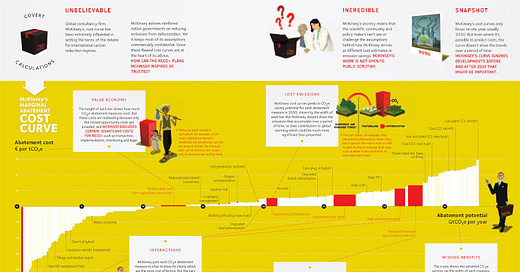Yesterday, Greenpeace released a report titled, “Bad Influence: How McKinsey-inspired plans lead to rainforest destruction.” The report highlights how advice from McKinsey & Co., one of the world’s top consulting firms, will result in an increase in the destructive logging it is, in theory at least, supposed to prevent.
McKinsey has provided advice to several governments hoping to cash in on REDD schemes, including Guyana, Papua New Guinea, Indonesia and the Democratic Republic of Congo. In its report, Greenpeace comments that,
[W]hen rainforest countries employ McKinsey to apply its trademarked cost curve to their REDD+ prospects, few if any of the resulting plans meet basic standards of accuracy, rigour, utility or ethical acceptability. If implemented in their current form, these plans could actually result in an increase of deforestation and carbon emissions.
At the heart of the problem is McKinsey’s cost curve. These deceptively simple graphics give a comparison between various options for reducing greenhouse gas emissions. Greenpeace describes McKinsey’s cost curve as “an optical illusion.”
Cost curves for REDD+ are not able, and do not seek, to integrate the web of social and environmental values associated with tropical forests beyond their carbon sequestration and storage potential. MAC [Marginal Abatement Cost] curves treat tropical forests like a carbon abatement technology, rather than recognising them as some of the world’s most complex living systems, supporting a staggering variety of biodiversity, as well as being of great economic and cultural importance to humans.
A graphic from the Greenpeace report highlights the problems (click on the image for a larger version):
In a Greenpeace press release, Sarah Shoraka, a Greenpeace Forest Campaigner, explains that,
“Greenpeace’s report shows the destructive and perverse effects that the McKinsey approach will have when applied to REDD+. Key problems with McKinsey’s REDD + work included that it does not lead to a reduction of deforestation, provides an incentive for rainforest governments to over estimate future levels of deforestation, omits important costs and barely acknowledges governance issues in rainforest countries.”
Comments from Jose Endundo, Environment Minister in the Democratic Republic of Congo, reveal two of the key problems with McKinsey’s advice on REDD to governments. First, McKinsey over-estimates the business as usual scenario, meaning that anything less than this nightmare vision can be counted as “avoided deforestation,” or “avoided threatened deforestation,” which is a speciality of Guyana’s President, Bharrat Jagdeo. Second, McKinsey under-estimates the impact of industrial logging on the forests.
Endundo told Bloomberg that “allowing for industrial exploitation of the forests can help protect them from illegal loggers.” He continued:
“We want to protect all the forests, and we want to do it in a way that it gives financial benefits for Congo, creates jobs and brings social benefits. We have adopted the McKinsey scenarios, and we want to do better than the scenarios described.”
Predictably enough, McKinsey is keen to defend its cost curves. They have after all been something of a money spinner for the company. McKinsey first published its global cost curve in January 2007, since when more than 25 countries have, according to McKinsey, “used national cost curves to inform their decision making.”
In a statement to Bloomberg, McKinsey explained that,
“We disagree with the report’s findings and stand firmly behind our work and our approach. In our work for public-sector clients, we provide a fact-base on the emission-reduction potential from forestry and land-use measures, which can be used to inform complex national debates on equitable low-carbon economic growth strategies.”
Oddly enough, McKinsey’s statement to Bloomberg disagrees with a statement put out by McKinsey on 9 March 2011 on the company’s Southeast Asia website. The statement, “McKinsey’s greenhouse gas abatement cost curve – setting the record straight,” is a response to Rainforest Foundation UK’s November 2010 critique of McKinsey’s advice on REDD.
McKinsey’s statement acknowledges the following serious problems with the cost curves:
One trade-off inherent in the methodology is that some types of costs, which must be taken into account when designing policy action, are left out. For example, we strip out from the calculations all country-specific and sector-specific costs and transfers such as taxes and subsidies. Moreover, program and transaction costs to implement abatement measures are excluded…
As a consequence, the abatement costs shown in the cost curve across a range of emissions reductions initiatives do not necessarily reflect the full costs of implementing those initiatives. Smallholder agriculture provides a good example.
[I]mplementing this abatement initiative could be significantly more expensive than suggested by the cost curve as the transaction costs of addressing millions of farmers across a large geographic expanse would be substantial.
In a statement on Rainforest Foundation UK’s website, Simon Counsell, Executive Director of the Rainforest Foundation UK comments,
“It is important that McKinsey’s have now recognised that their cost curves for climate change abatement probably substantially underestimate the real cost of reducing carbon emissions from deforestation, particularly in terms of dealing with the activities of poor farmers. Policy makers now need to start basing their priorities for tackling climate change on real estimates of cost, rather than one-size-fits-all economic models which could lead to disastrous results. REDD may not prove to be the low-hanging fruit of climate change abatement that many have hoped for and speculated on.”








Comments following the original post on REDD-Monitor.org are archived here: https://archive.ph/EVHnV#selection-4317.0-4317.10